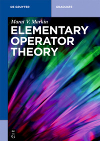- About MAA
- Membership
- MAA Publications
- Periodicals
- Blogs
- MAA Book Series
- MAA Press (an imprint of the AMS)
- MAA Notes
- MAA Reviews
- Mathematical Communication
- Information for Libraries
- Author Resources
- Advertise with MAA
- Meetings
- Competitions
- Programs
- Communities
- MAA Sections
- SIGMAA
- MAA Connect
- Students
- MAA Awards
- Awards Booklets
- Writing Awards
- Teaching Awards
- Service Awards
- Research Awards
- Lecture Awards
- Putnam Competition Individual and Team Winners
- D. E. Shaw Group AMC 8 Awards & Certificates
- Maryam Mirzakhani AMC 10 A Awards & Certificates
- Two Sigma AMC 10 B Awards & Certificates
- Jane Street AMC 12 A Awards & Certificates
- Akamai AMC 12 B Awards & Certificates
- High School Teachers
- News
You are here
Elementary Operator Theory

Publisher:
De Gruyter
Publication Date:
2020
Number of Pages:
410
Format:
Paperback
Series:
De Gruyter Textbook
Price:
74.99
ISBN:
978-3-11-060096-4
Category:
Textbook
[Reviewed by , on ]
Frederic Morneau-Guerin
01/16/2021
Since Markin is the author of a text titled Elementary Functional Analysis, we could have expected Elementary Operator Theory to be designed to be suitable as a reference book in the context of a semester-long course that could be taken by students who had completed an initial course in functional analysis. Curiously, the mathematics professor at California State University has chosen instead with this new book to compete with his previous one. Elementary Operator Theory is intended to provide readers with appropriate content for an introductory course to operator theory for which the prerequisites are intentionally set sufficiently low to be taken by newly registered students in a graduate program.
Chapter 1 is a compilation of definitions and elementary set-theoretic results. An appendix includes a more in-depth discussion concerning the axiom of choice, Zorn’s lemma, the well-ordering principle and Hausdorff’s maximal principle.
Chapter 2 contains a full and surprisingly in-depth explanation of the theory of metric spaces and point-set topology. The theory is developed ab initio and the chapter proceeds at a good pace up to addressing the Baire category theorem, Banach’s fixed-point theorem, the Arzelà–Ascoli theorem and the Peano existence theorem.
In chapters 3 and 4, the author develops the theory of normed vector spaces and then presents some of the main theorems of functional analysis such as the open mapping theorem, the inverse mapping theorem, the closed graph theorem, and the uniform boundedness principle. Given the substantial overlap with an introductory course in functional analysis, it is difficult to explain the author’s choice not to cover the Hahn–Banach theorem.
It is only in chapters 5 and 6 that actual operator theory is addressed. The first of these two chapters develops the theory in the general framework of Banach spaces (i.e. the Gelfand’s spectral radius theorem, the spectral mapping theorem for operator polynomials, alternative de Fredholm, the Riesz–Schauder theorem), while the second of these chapters focuses on certain particularities observed in the specific context of Hilbert spaces (i.e. the spectral theorem for compact self-adjoint operators).
Although Markin generously distributes the verifications left as exercises for the readers (the text contains a total of 432) and examples, he is far less generous with detailed explanations and worked examples. Additionally, the text is densely written – it is absent of historical background and references, and features concise writing style and frequent recourse to notation that is cumbersome i.e. (p. 156)
\( \mathbb{C} \ni \alpha + i\beta, X^{\mathbb{C}} \ni (x,y) \mapsto (\alpha + i \beta)(x,y) := (\alpha x - \beta y, \beta x + \alpha y) \in X^{\mathbb{C}} \)
In summary, this text seems to be of primary use for any educators who need to give a master’s level introductory course on operator theory in around 45 hours intended for an audience with a varied level of prior knowledge. With its few worked examples, however, it would be a challenge to use this work in a context of independent learning or as an instructor’s manual.
Frederic Morneau-Guerin is a professor in the Department of Education at Universite TELUQ. He holds a Ph.D. in abstract harmonic analysis.
See the publisher's website.
- Log in to post comments




